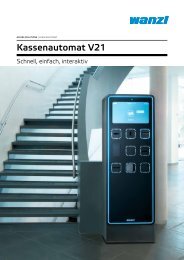WORKBOOK
Sie wollen auch ein ePaper? Erhöhen Sie die Reichweite Ihrer Titel.
YUMPU macht aus Druck-PDFs automatisch weboptimierte ePaper, die Google liebt.
Unlust-System ausgelöst. Beide Seiten bestehen jeweils aus zwei<br />
Subsystemen: einem Belohnungs-Erwartungs- und Bestrafungs-<br />
Erwartungs-System (antizipatorisch) und einem System, das<br />
beim Eintreten der Belohnung oder Bestrafung z.B. Freude oder<br />
Schmerz auslöst (konsumatorisch).<br />
Emotionen sind in ihrer Stärke variabel. Vom Wohlergehen lässt<br />
sich die Stimmung bis zur Freude steigern. In negativer Form gibt<br />
es diese Steigerungen auch: Eine leichte Unsicherheit kann sich<br />
bis zur extremen Panik verstärken, oder aus einem leichten Ärger<br />
über den anderen kann glühender Zorn werden, da die Emotionssysteme<br />
im Gehirn sehr eng mit dem allgemeinen Erregungssystem<br />
im Gehirn verknüpft sind.<br />
aversion system. Each side also consists of two sub-systems:<br />
a reward anticipation and punishment anticipation system, and<br />
a system that triggers joy or pain when the reward or punishment<br />
is received.<br />
Emotions vary in strength. A feeling of satisfaction can go all<br />
the way up to pleasure. These scales also exist on the negative<br />
side. Slight uncertainty can grow all the way to extreme panic,<br />
and slight annoyance with another person can become seething<br />
fury as the emotional systems in the brain are very closely linked<br />
to the brain’s general stimulus system.<br />
Die Limbic® Map:<br />
Der Emotions- und Werteraum des Menschen<br />
Da die drei großen Emotionssysteme (inklusive Submodule) meist<br />
zeitgleich aktiv sind, gibt es Mischungen. Die Mischung von Dominanz<br />
und Stimulanz beispielsweise ist Abenteuer, die Mischung<br />
aus Stimulanz und Balance ist Offenheit. Kontrolle schließlich ergibt<br />
sich aus der Mischung zwischen Balance und Dominanz.<br />
Die folgende Limbic® Map zeigt die funktionale Gesamtstruktur<br />
der Emotionssysteme inkl. Werte auf.<br />
The Limbic® Map:<br />
the geography of our emotions and values<br />
Since all three main emotional systems (and their sub-modules)<br />
are usually active at the same time, they combine in different<br />
ways. Adventure, for example, is a combination of dominance and<br />
stimulus, while a mixture of stimulus and balance results in openness.<br />
Finally, control is the result of mixing balance and dominance.<br />
The following Limbic® Map shows the overall functional<br />
structure of the emotional systems, with values.<br />
Stimulanz<br />
Stimulus<br />
Spaß<br />
Fun<br />
Humor<br />
Humour<br />
Genuss<br />
Pleasure<br />
Kunst<br />
Art<br />
Träumen<br />
Dreaming<br />
Spiel<br />
Game<br />
Fantasie<br />
Imagination<br />
Sinnlichkeit<br />
Sensuality<br />
Kreativität<br />
Creativity<br />
Extravaganz<br />
Extravagance<br />
Neugier<br />
Curiosity<br />
Leichtigkeit<br />
Easiness<br />
Fantasie Genuss / Imagination Pleasure<br />
Offenheit<br />
Candour<br />
Poesie<br />
Poetry<br />
Geselligkeit<br />
Sociability<br />
Impulsivität<br />
Impulsiveness<br />
Risikofreude<br />
Adventurousness<br />
Individualismus<br />
Individualism<br />
Sexualität weiblich<br />
Sexuality, female<br />
Freundschaft<br />
Friendship<br />
Heimat<br />
Home<br />
Nostalgie<br />
Nostalgia<br />
Spontanität<br />
Spontaneity<br />
Familie<br />
Family<br />
Rebellion<br />
Rebellion<br />
Jagd<br />
Hunt<br />
Bindung<br />
Bonding<br />
Sicherheit<br />
Safety<br />
Gerechtigkeit<br />
Justice<br />
Gesundheit<br />
Health<br />
Mut<br />
Courage<br />
Sexualität männlich<br />
Sexuality, male<br />
Toleranz<br />
Tolerance<br />
Flexibilität<br />
Flexibility<br />
Herzlichkeit<br />
Geniality<br />
Vertrauen<br />
Trust<br />
Fürsorge<br />
Caring<br />
Natur<br />
Nature<br />
Abenteuer / Adventure<br />
Geborgenheit<br />
Security<br />
Treue<br />
Faithfulness<br />
Sauberkeit<br />
Cleanliness<br />
Tradition<br />
Tradition<br />
Balance<br />
Balance<br />
Sieg<br />
Victory<br />
Raufen<br />
Tussling<br />
Gehorsamkeit<br />
Obedience<br />
Kampf<br />
Struggle<br />
Autonomie<br />
Autonomy<br />
Stolz<br />
Pride<br />
Verlässlichkeit<br />
Tenacity<br />
Disziplin Kontrolle / Discipline Control<br />
Funktionalität<br />
Functionality<br />
Ordnung<br />
Order<br />
Hygiene<br />
Hygiene<br />
Qualität<br />
Quality<br />
Ruhm<br />
Renown<br />
Freiheit<br />
Freedom<br />
Macht<br />
Power<br />
Status<br />
Ehre Status<br />
Honour<br />
Leistung<br />
Performance<br />
Sparsamkeit<br />
Economy<br />
Elite<br />
Elite<br />
Durchsetzung<br />
Assertiveness<br />
Effizienz<br />
Efficiency<br />
Ehrgeiz<br />
Fleiß Ambition<br />
Industry<br />
Logik<br />
Hartnäckigkeit<br />
Logic<br />
Tenacity<br />
Disziplin<br />
Discipline<br />
Moral<br />
Präzision<br />
Morality Precision<br />
Pflicht<br />
Duty Askese<br />
Asceticism<br />
Dominanz<br />
Dominance<br />
Die strategische Emotionalisierung in der Ladengestaltung<br />
Wer einen Einkaufsbummel macht und auf dem Rückweg von einem<br />
Hermès- oder Gucci-Shop noch schnell bei ALDI vorbeischaut,<br />
wird spüren, dass beide Ladengestaltungen extrem unterschiedlich<br />
sind. Bei den Exklusiv-Shops werden vom Eingang über den<br />
gesamten Verkaufsraum nur edelste Materialien verbaut, einzelne<br />
Produkte werden durch Lichtgestaltung inszeniert – völlig anders<br />
dagegen beim Discounter: Preiswerter, einfacher Ladenbau,<br />
Massenpräsentation und helle, nicht akzentuierte Grundbeleuchtung.<br />
Beide Ladengestaltungen sind erfolgreich.<br />
Damit wird deutlich: „Die“ ideale Ladengestaltung gibt es offensichtlich<br />
nicht. Neben den funktionalen Aspekten des Geschäfts,<br />
nämlich des physischen Verfügbarmachens von Ware, sind Läden<br />
vor allem emotionale Bühnen, die durch das Visual Merchandising<br />
die Ware aktiv anbieten und durch das Shop-Design den emotionalen<br />
Kontext des Kaufanlasses bieten.<br />
Psychologie und Hirnforschung haben in vielen Untersuchungen<br />
deutlich gemacht, wie emotionale Kontextveränderungen auf die<br />
Preis-/Wert-Beurteilung von Waren Einfluss nehmen.<br />
Strategic emotionalisation in store planning<br />
If, after shopping at a Hermès or Gucci store, you make a quick<br />
stop at ALDI on your way home, you will feel the extreme difference<br />
between the designs of the two shops. In the exclusive<br />
stores, only the best materials are used from the entrance to the<br />
entire sales area, and individual products are framed through the<br />
use of light. It’s a completely different story at the discounter<br />
with its cheap, simple fittings, mass presentation and bright, uniform<br />
background lighting. Both of these store designs are successful.<br />
This shows us that there is clearly no such thing as the “ideal”<br />
store design. Apart from the functional aspects of a business<br />
(i.e. making goods physically available), shops are above all emotional<br />
platforms that actively offer products by means of visual<br />
merchandising, and provide an emotional context for the act of<br />
purchasing through their design.<br />
Psychology and brain research have shown through many studies<br />
how changes in the emotional context impact how the price and<br />
value of goods are perceived.<br />
→<br />
77


















